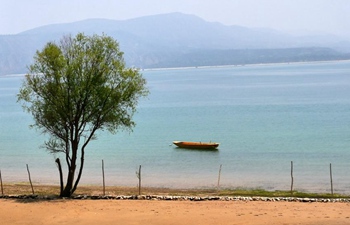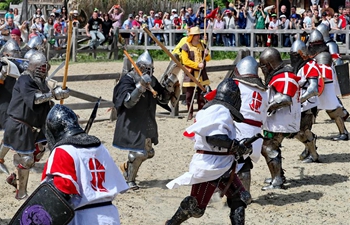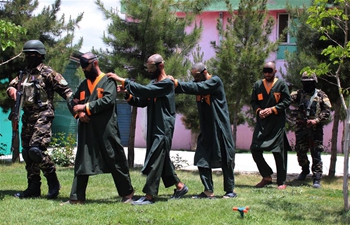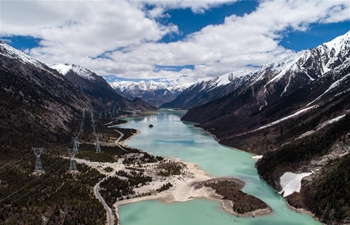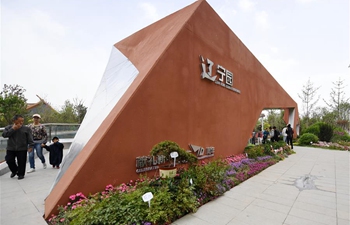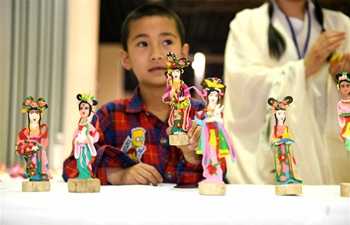
Chinese passenger cars arrive and stop at Havana, Cuba, May 20, 2019. Intense and blue, like the bright Cuban sky, are the Chinese passenger cars that will soon be put into operation as part of an ambitious and costly program to modernize Cuba's railroad system. The island has just received the first 56 cars, from a batch of 240 which it acquired with a Chinese credit, payable in 15 years, and will arrive in Havana at a rate of 80 each year from 2019 to 2021. This is the first time in 44 years that Cuba has received new railroad cars. Before it, the island's railroad system had been operated with second-hand cars for decades. Now, with the help of the China National Machinery Import and Export Corporation (CMC), the CRRC Tangshan Co., Ltd. specifically manufactured the brand-new cars for the Caribbean nation. (Xinhua/Joaquin Hernandez)
By Raul Menchaca
HAVANA, May 20 (Xinhua) -- Intense and blue, like the bright Cuban sky, are the Chinese passenger cars that will soon be put into operation as part of an ambitious and costly program to modernize Cuba's railroad system.
The island has just received the first 56 cars, from a batch of 240 which it acquired with a Chinese credit, payable in 15 years, and will arrive in Havana at a rate of 80 each year from 2019 to 2021.
This is the first time in 44 years that Cuba has received new railroad cars. Before it, the island's railroad system had been operated with second-hand cars for decades.
Now, with the help of the China National Machinery Import and Export Corporation (CMC), the CRRC Tangshan Co., Ltd. specifically manufactured the brand-new cars for the Caribbean nation.
"There is a great rehabilitation program for the entire railway industry in general, and in particular these passenger cars that we have contracted with China respond to our government's policy of providing a quality service to the population," Vice President of Cuba's Council of Ministers Ricardo Cabrisas told Xinhua.
This is "a program that represents one of the governmental priorities," Cabrisas said, who seemed satisfied after touring three of the comfortable cars and trying one of the reclining and rotating seats.
On his part, the CMC Vice President Mr. Zhao Jun said that for several years they have been working with the island's Ministry of Transport to support the update of the country's railway system.
"We are willing to help Cuba to modernize that system and improve the level of transportation in the country," Zhao said.
With those first 56 cars, and other 24 to be received in two weeks, the Union of Railways of Cuba (UFC) expects to form four trains of 12 cars each, almost twice the number of the current ones with only seven cars.
Each car has 72 capacities, which will give room for 720 passengers in a railway formation about 325 meters long, something that is rarely seen on the island.
"These are cars that can be considered as a tailor-made suit," said UFC Director General Eduardo Hernandez who said that the design and manufacturing process was carried out by Chinese and Cuban engineers.
"They are cars with benefits that meet the international standards of passenger transportation and are also designed for Cuba, that is, with the standards that the Cuban railway needs," the director said.
Hernandez stressed that they are working to make sure that the cars will be in service by this summer,as most of the passengers on the island are ferried in summer, the holiday season.
Before being put into service, the trains will receive an exhaustive review and then take some tests of crossing without cargo so as to check the technical and operational conditions on the Cuban railroads.
According technicians' calculation, the use of these trains will help reduce the traveling time by between two and three hours.
The new trains will reach the cities of Guantanamo, on the eastern tip of the island, and Santiago de Cuba, some 860 kilometers east of Havana, and will allow the reuse of a 730-kilometer line abandoned since 2006 between Havana and Holguin, also in the east.
"Without a doubt it is going to be a technological change and also in the quality of the service in the Cuban railways," Hernandez said with confidence.




